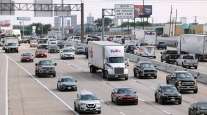'People Should Be Getting Ready:' Snowstorm Targets East Coast for Jan. 22
Depending on the path "Winter Storm Jonas" takes and how it develops, snow could fall from West Virginia to New England, blanketing New York City, Washington, Philadelphia and Boston.
Snow is forecast to start first in Washington during the day Jan. 22 and then later that night in New York and Boston.
Weather.com reported it could be the first storm in 13 years to dump a foot of snow on the entire Northeast megalopolis. USA Today said more than 50 million people could be affected by snowfall heavy enough to disrupt travel by road, rail and air.
“There is pretty good confidence for a significant storm to impact the East Coast beginning [Jan. 22],” said Rich Otto, a meteorologist with the U.S. Weather Prediction Center in College Park, Maryland. “I don’t want to start naming numbers, or say who is going to get it worse because it is still too early.”
2 systems will bring snow to the Central & Eastern U.S. this week. Just 1 hour away from #WUTV on @weatherchannel! pic.twitter.com/AtScXezAdM
— Weather Underground (@wunderground) January 19, 2016
Meanwhile, another storm, Ilias, already is hitting places such as Kansas City and St. Louis, and will be disrupting the Central Plains and Ohio Valley midweek.
The large East Coast cities are lagging normal snowfall totals. New York has only received 0.4 of an inch (1 centimeter) this season, or 8.6 inches less than normal, the National Weather Service said. Philadelphia, Washington and Baltimore are all inches behind an average season, and Boston is more than a foot below the 30-year average.
“This could bring the numbers back up to normal,” Otto said.
The storm could peak in the Mid-Atlantic, meaning Washington and Philadelphia could bear the brunt of the heaviest snow, said Todd Crawford, principal scientist at WSI in Andover, Massachusetts.
“At this point, it looks like the jackpot will be in Virginia, inside the Roanoke-Richmond-D.C. triangle,” Crawford said. It’s possible that 18 inches or more could fall there, he said.
Winter Storm #Ilias will bring heavy #snowfall tonight into tomorrow. Get the forecast. https://t.co/yPjn1Mg4aU
— The Weather Channel (@weatherchannel) January 19, 2016
The current timing of the storm is a positive, said Paul Walker, a meteorologist with AccuWeather Inc. in State College, Pennsylvania. By arriving on the weekend it won’t have the chance to disrupt most commuters or close schools throughout the region.
“It looks like there is going to be snow in New York City arriving Friday night through the day on Saturday, ending Saturday night,” Walker said. About 6 to 10 inches could fall from West Virginia to New England, he said.
Of course, with a few days to go and the seed of the storm still just a low-pressure system out over the Pacific Ocean, a lot can go wrong.
There is some dispute among the models about how powerful the storm will end up being by the time it develops off the U.S. East Coast, said Rob Carolan, a meteorologist at Hometown Forecast Services Inc. in Nashua, New Hampshire.
“I don’t know if it is going to be the end of the world, it may end up being a moderate snowstorm for a lot of folks,” Carolan said.
He added that it is possible as much as 6 inches could fall from Washington to New England. If that happens, it would be the biggest storm of the year for many places.
The storm’s track will make all the difference, Otto said. Just about a year ago, forecasts called for New York City to get as much as 3 feet of snow from a storm heading up the coast. The track of the storm shifted and eastern Long Island and New England received the worst, while New York escaped with less than a foot.
“People said ‘Hey, what happened to the snow?' ” Otto said. “Well, it happened, but it was a little east of you.”
Otto said forecasters will have better clarity as the week progresses. Until then, it might be a good idea to remember where the shovel and the rock salt are.
“People should be getting ready,” Walker said. “Winter is going to arrive. We have been spoiled.”



